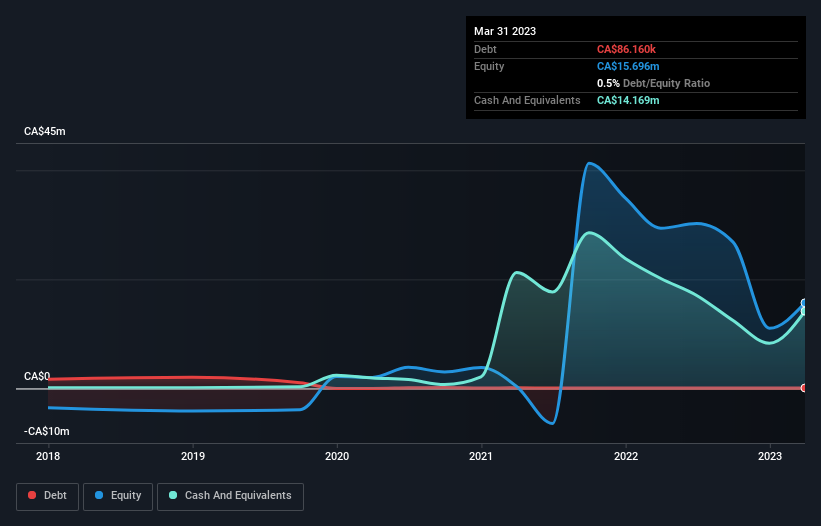- Canada
- /
- Aerospace & Defense
- /
- CNSX:DPRO
Is Draganfly (CSE:DPRO) In A Good Position To Deliver On Growth Plans?
We can readily understand why investors are attracted to unprofitable companies. For example, although Amazon.com made losses for many years after listing, if you had bought and held the shares since 1999, you would have made a fortune. But while the successes are well known, investors should not ignore the very many unprofitable companies that simply burn through all their cash and collapse.
Given this risk, we thought we'd take a look at whether Draganfly (CSE:DPRO) shareholders should be worried about its cash burn. For the purposes of this article, cash burn is the annual rate at which an unprofitable company spends cash to fund its growth; its negative free cash flow. Let's start with an examination of the business' cash, relative to its cash burn.
Check out our latest analysis for Draganfly
How Long Is Draganfly's Cash Runway?
You can calculate a company's cash runway by dividing the amount of cash it has by the rate at which it is spending that cash. As at March 2023, Draganfly had cash of CA$14m and such minimal debt that we can ignore it for the purposes of this analysis. Importantly, its cash burn was CA$19m over the trailing twelve months. So it had a cash runway of approximately 9 months from March 2023. To be frank, this kind of short runway puts us on edge, as it indicates the company must reduce its cash burn significantly, or else raise cash imminently. You can see how its cash balance has changed over time in the image below.

How Well Is Draganfly Growing?
Draganfly reduced its cash burn by 15% during the last year, which points to some degree of discipline. But the revenue dip of 5.2% in the same period was a bit concerning. Considering both these factors, we're not particularly excited by its growth profile. While the past is always worth studying, it is the future that matters most of all. So you might want to take a peek at how much the company is expected to grow in the next few years.
Can Draganfly Raise More Cash Easily?
Since Draganfly revenue has been falling, the market will likely be considering how it can raise more cash if need be. Issuing new shares, or taking on debt, are the most common ways for a listed company to raise more money for its business. One of the main advantages held by publicly listed companies is that they can sell shares to investors to raise cash and fund growth. By comparing a company's annual cash burn to its total market capitalisation, we can estimate roughly how many shares it would have to issue in order to run the company for another year (at the same burn rate).
Draganfly has a market capitalisation of CA$69m and burnt through CA$19m last year, which is 27% of the company's market value. That's not insignificant, and if the company had to sell enough shares to fund another year's growth at the current share price, you'd likely witness fairly costly dilution.
Is Draganfly's Cash Burn A Worry?
On this analysis of Draganfly's cash burn, we think its cash burn reduction was reassuring, while its cash runway has us a bit worried. Summing up, we think the Draganfly's cash burn is a risk, based on the factors we mentioned in this article. On another note, Draganfly has 5 warning signs (and 1 which makes us a bit uncomfortable) we think you should know about.
Of course Draganfly may not be the best stock to buy. So you may wish to see this free collection of companies boasting high return on equity, or this list of stocks that insiders are buying.
New: Manage All Your Stock Portfolios in One Place
We've created the ultimate portfolio companion for stock investors, and it's free.
• Connect an unlimited number of Portfolios and see your total in one currency
• Be alerted to new Warning Signs or Risks via email or mobile
• Track the Fair Value of your stocks
Have feedback on this article? Concerned about the content? Get in touch with us directly. Alternatively, email editorial-team (at) simplywallst.com.
This article by Simply Wall St is general in nature. We provide commentary based on historical data and analyst forecasts only using an unbiased methodology and our articles are not intended to be financial advice. It does not constitute a recommendation to buy or sell any stock, and does not take account of your objectives, or your financial situation. We aim to bring you long-term focused analysis driven by fundamental data. Note that our analysis may not factor in the latest price-sensitive company announcements or qualitative material. Simply Wall St has no position in any stocks mentioned.
About CNSX:DPRO
Draganfly
Develops, manufactures, and sells cutting-edge unmanned and remote data collection and analysis platforms and systems in the United States and Canada.
Flawless balance sheet with low risk.
Market Insights
Community Narratives



